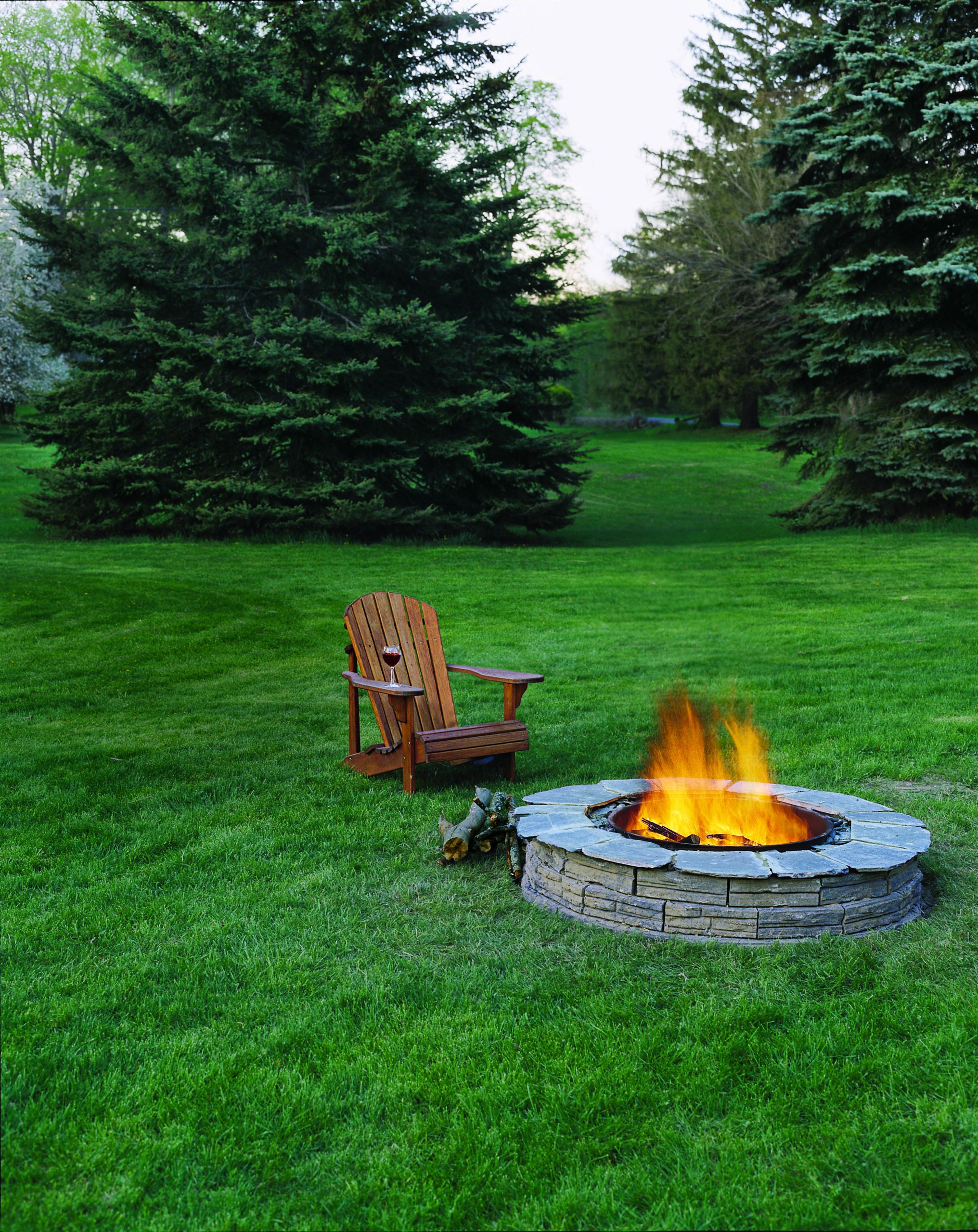Project details
Skill
Cost
Estimated Time
Building a DIY fire pit is a great way to grow your outdoor living space and create a nice gathering spot for family and friends. In this guide, we’ll walk you through the process of building your own fire pit, from planning to finishing touches. We’ve compiled all the information needed to create a safe and customized outdoor fire pit.
Understanding Fire Pit Basics
Before diving into the construction process, you need to understand the fundamentals of fire pits and the available options. This will help you make informed decisions about your project to create a fire pit that complements your outdoor space.
Types of Fire Pits
For this DIY project, we’ll focus on building an above-ground fire pit using concrete blocks. However, fire pits come in many different styles and designs, as seen below:
- Above-ground: Built on top of the ground and more common for DIY projects.
- Gas-powered: These use natural gas or propane for a cleaner burn and easier control.
- In-ground: These are dug into the ground and lined with fire-resistant materials.
- Portable: Manufactured units that can be moved around your yard.
Benefits of a DIY Fire Pit
Creating your own fire pit offers several advantages, including customization to tailor the size, shape, and design to fit your outdoor area. DIY projects are often more cost-effective than buying a pre-made fire pit or hiring a professional, as this eliminates labor and installation costs.
Planning Your Fire Pit Project
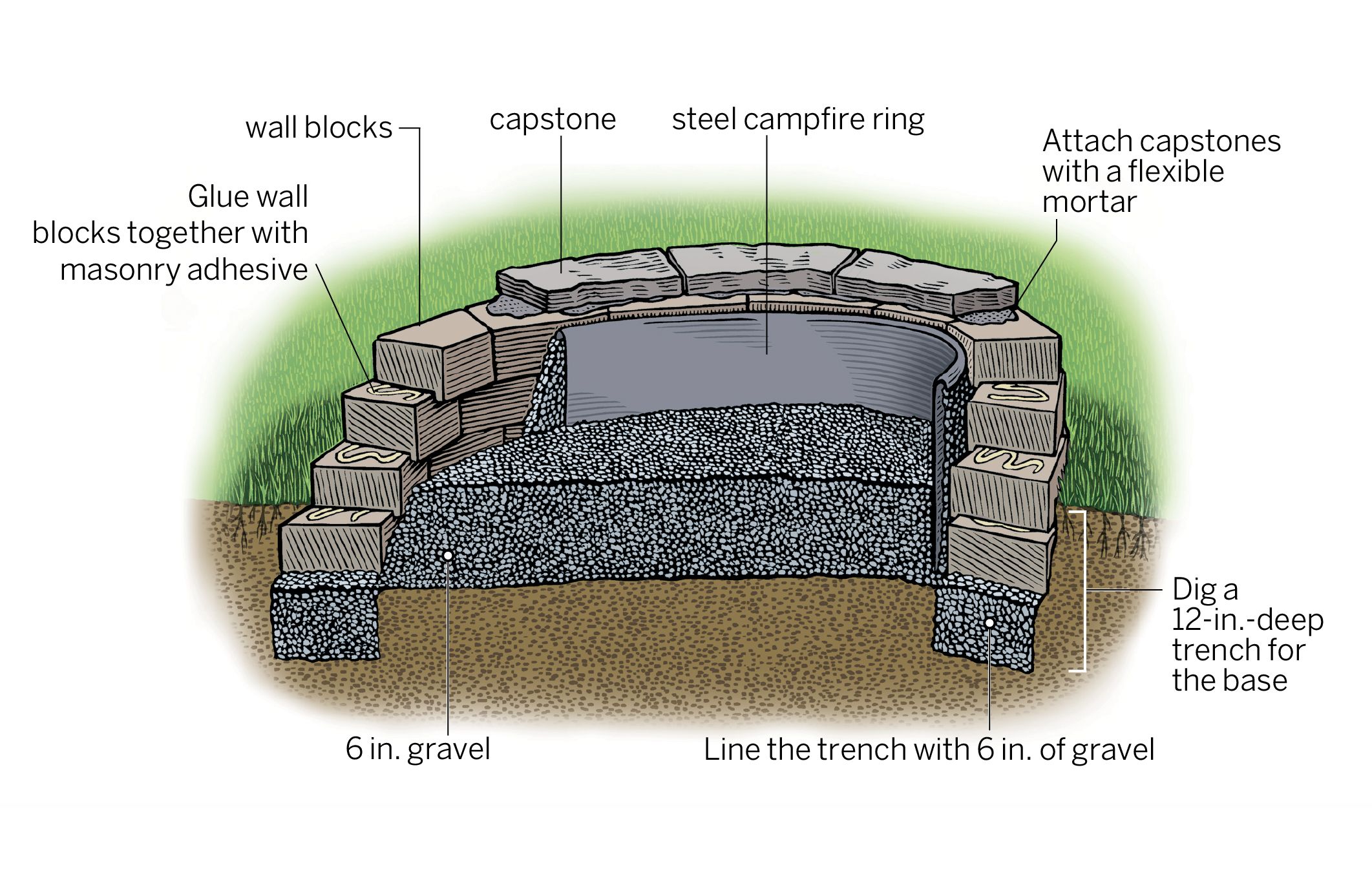
Proper planning will make for a successful DIY fire pit project. This involves deciding on the location, size, and materials that will all impact the functionality and design of your fire pit.
Choosing the Right Location
Selecting the right spot for your fire pit impacts the safety of your home and yourself. Position the pit to minimize smoke blowing towards seating areas or your home, and choose a flat area for stability and proper drainage. Lastly, check that there are no low-hanging branches or power lines above the pit.
Determining Size and Shape
The size and shape of your fire pit will depend on your available space and personal preferences. Many fire pits have an inside diameter between 36 and 44 inches and a height of about 12 inches above the ground. While circular pits are more common, square and rectangular designs can also work depending on layout and preference.
Selecting Materials
When choosing materials, consider durability and design. Concrete blocks are affordable, easy to work with, and come in different styles that mimic natural stone. A steel fire ring protects the concrete from heat damage.
Gravel should be used for drainage and as a base for the fire pit. Masonry adhesives keep the blocks securely in place, and capstones provide a finished look to protect the top of the wall. When selecting materials, consider factors like heat resistance, durability, and how well they complement your outdoor space.
Essential Tools and Materials
Having the right tools and materials on hand before starting your project will make for a smooth building process. Below is what you’ll need for this project:
Required Tools
- 3-inch cold chisel
- Brick hammer
- Caulking gun
- Hand tamper
- Level (2-foot and 4-foot)
- Rubber mallet
- Safety gear (gloves, safety glasses, dust mask)
- Spade or shovel
Necessary Materials
- 3/4-inch drainage gravel
- Capstones
- Concrete blocks (enough for 3–4 courses plus extras)
- Masonry adhesive
- Patio base material (for leveling)
- Steel fire ring (36–44 inches in diameter)
Preparing the Site
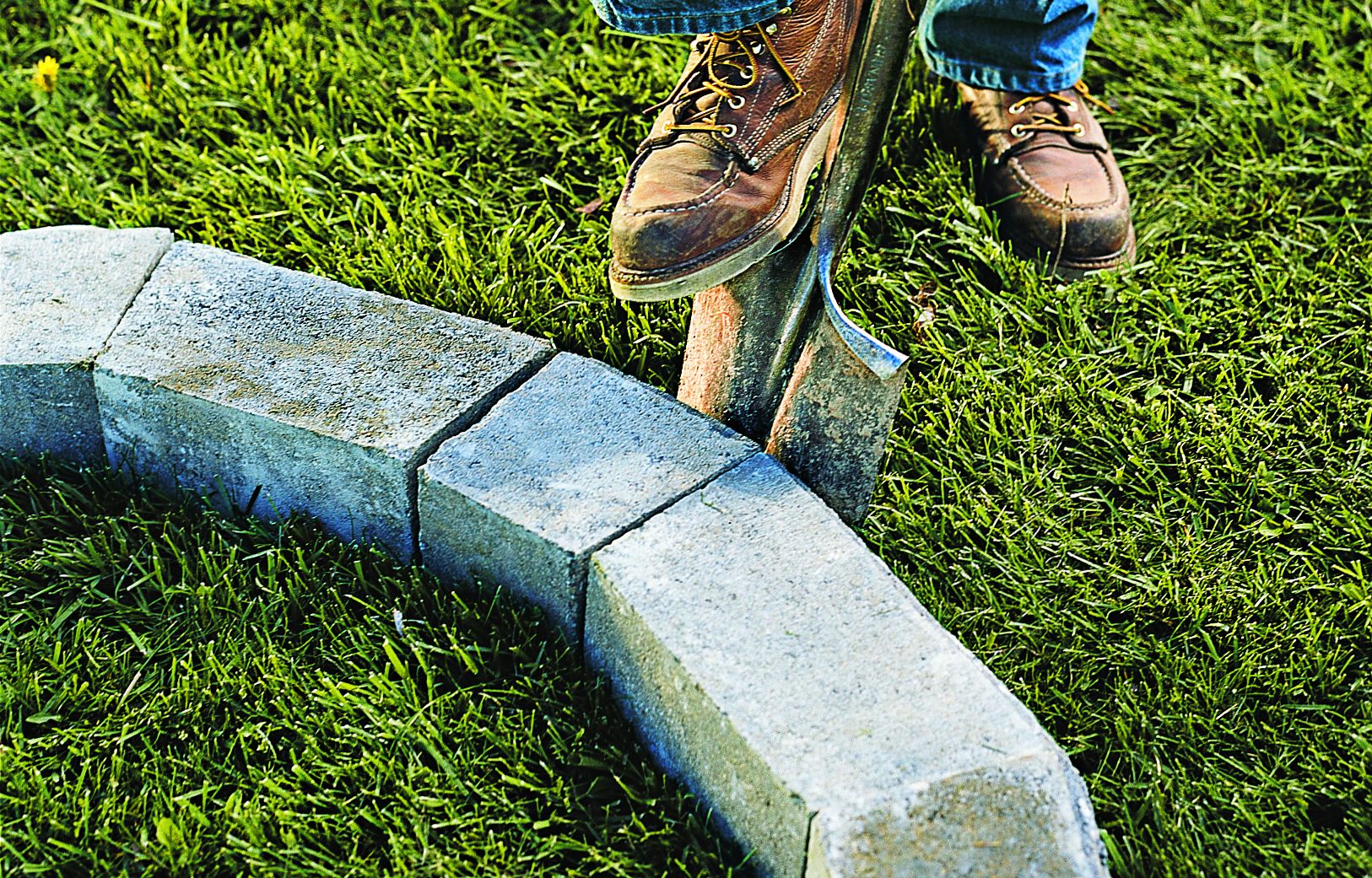
Proper site preparation gives you a stable and long-lasting fire pit. This phase involves marking the area, excavating the ground, and creating a level foundation for your pit.
Marking the Area
Begin by marking out the location of your fire pit:
- Place a stake in the center of your chosen spot.
- Tie a string to the stake and extend it out to half the desired diameter of your pit.
- Walk around the stake, using the string as a guide to mark a circle on the ground with spray paint.
Excavating the Ground
Once you’ve marked the area, it’s time to start digging:
- Dig a circular trench about 12 inches deep and as wide as one block along the marked circle.
- Excavate the interior area to a depth of 6 inches.
- Check that the sides of the trench are straight and even.
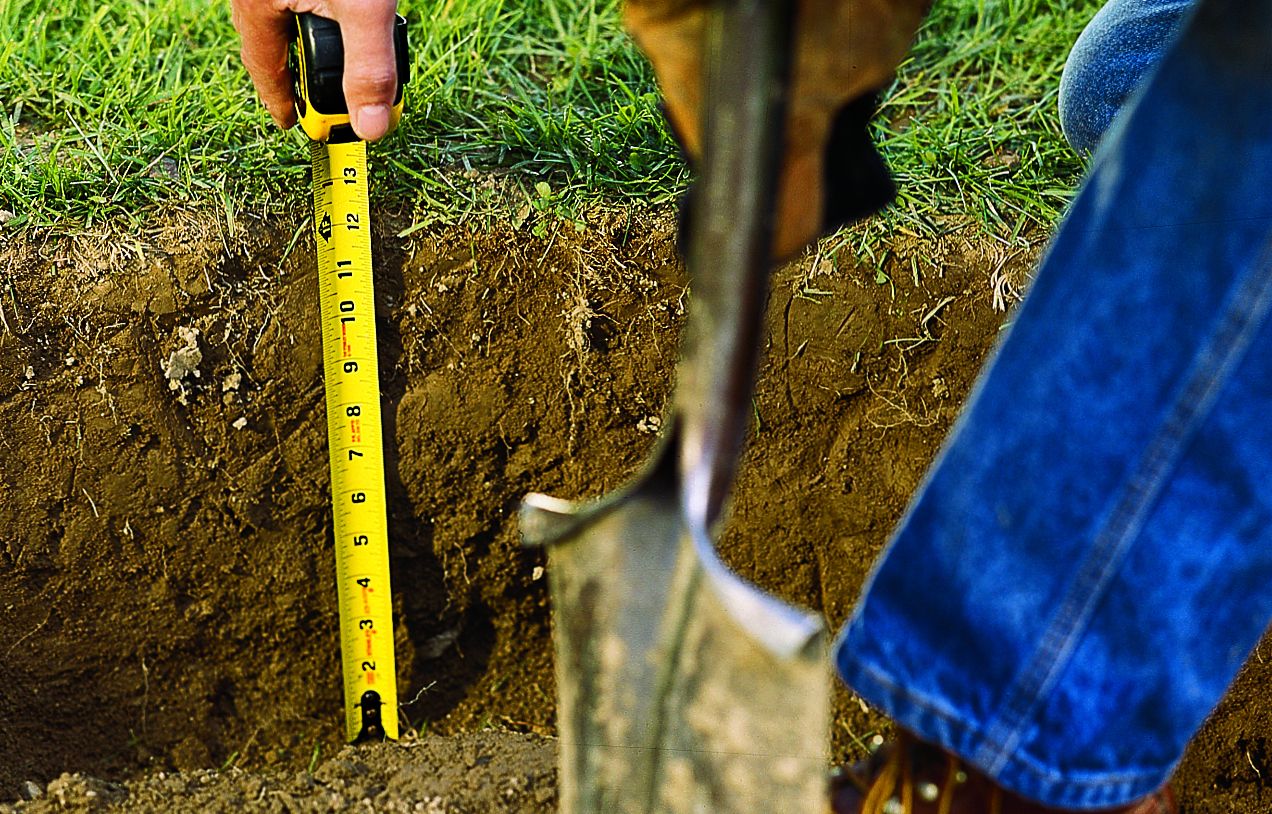
Creating a Level Foundation
Taking the time to create a solid, level foundation will make the rest of the construction process much easier and result in a more stable fire pit. This steep also allows for proper drainage, preventing water accumulation and frost heaving. Create a foundation following these steps:
- Fill the trench with six inches of 3/4-inch drainage gravel.
- Use a hand tamper to compact the gravel firmly.
- Check the level across the entire area, adding or removing gravel as needed for an even surface.
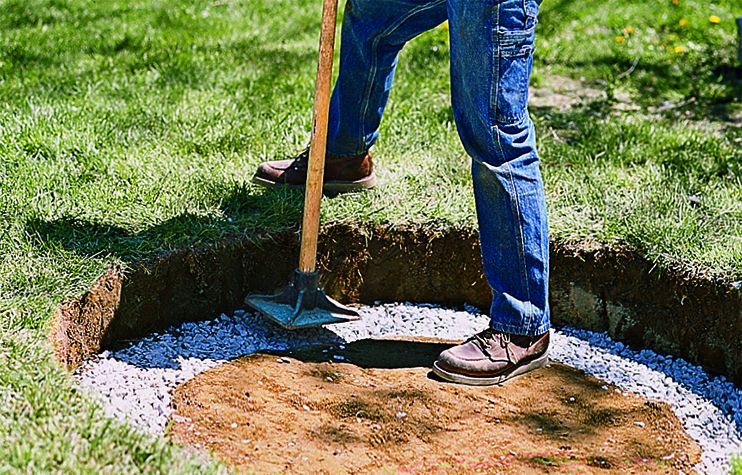
Building the Fire Pit Base
With the site prepared, you can start building the base of your fire pit. This involves laying the first course of blocks and setting the foundation for the structure.
A small hit with a mallet can make a big adjustment, so work slowly and carefully, block by block. This will pay off for the stability and appearance of your fire pit. The first course of blocks will determine the shape and strength of your fire pit:
- Place the first block in the ring, checking that it’s level both side to side and front to back.
- Use the rubber mallet to tap it into place and adjust as needed.
- Continue placing blocks around the circle, making sure each one is level and tightly butted against its neighbor.
- Use a four-foot level to check across the ring occasionally, making small adjustments as you go.
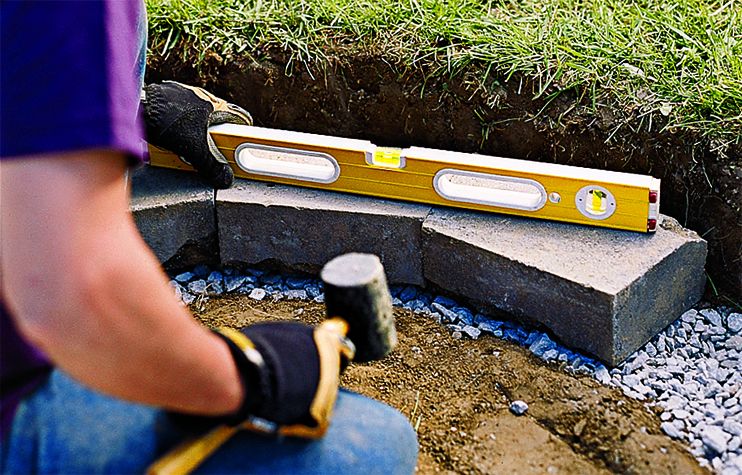
Constructing the Fire Pit Walls
With the base in place, you can now build up the walls of your fire pit. This process involves carefully stacking and securing additional courses of blocks to create a sturdy and even structure.
Assembling Subsequent Courses
Building the walls requires patience, but by following the steps below, you’ll have a stable structure.
- Start the second course by placing a block centered over the joint between two blocks in the first course.
- Continue around the circle, staggering the joints for added strength.
- Use a level to check that each block is aligned horizontally and vertically.
- Repeat this process for the third and fourth courses, maintaining the staggered pattern.
Using Masonry Adhesive
For the stability of your fire pit, use masonry adhesive between each course:
- Apply a zigzag bead of adhesive on top of two adjacent blocks using a caulking gun.
- Place the next block on top, centering it over the seam between the two below.
- Press down firmly to set the block in place, working quickly before the adhesive sets.
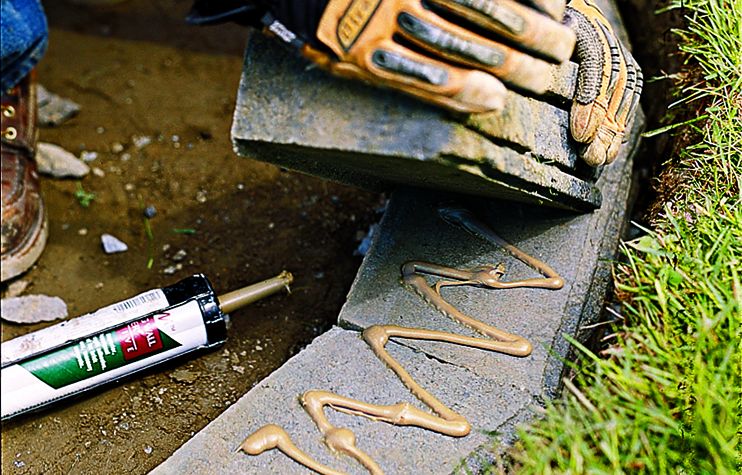
Installing the Fire Ring
The steel fire ring protects the concrete blocks from heat damage. To install correctly:
- Insert the fire ring into the circle.
- Adjust it to sit level with the top of the block wall.
- Fill any gaps between the ring and the blocks with gravel up to the top.
Finishing Touches
The final steps in building your DIY fire pit involve adding the capstones and any decorative elements. These finishing touches provide added protection and functionality.
Capping the Blocks
Capstones provide a polished look and protect the top of your fire pit wall. For a more natural look, you can use irregular-shaped stones. Follow these steps:
- Arrange the capstones loosely on top of the wall to plan their placement.
- Mark and cut the stones as needed to fit snugly around the circle.
- Apply masonry adhesive to the top of the wall.
- Place each capstone, checking that it’s level and has a slight overhang on both the inside and outside of the pit.
- Use a rubber mallet to tap the stones into place gently.
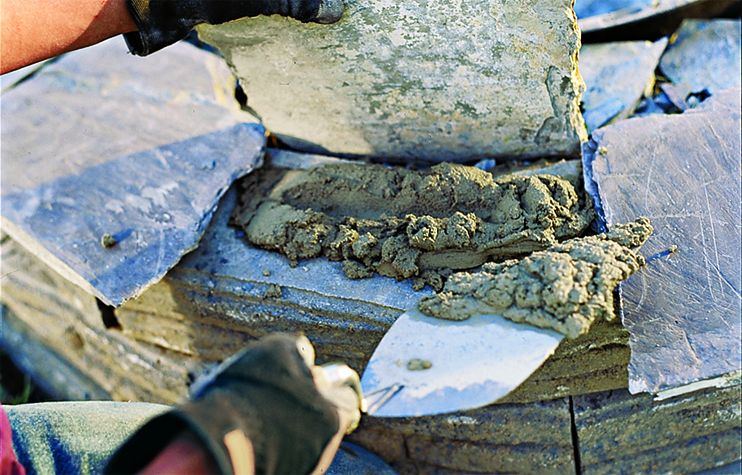
Adding Decorative Elements
You can also add decorative elements if desired. Consider adding a paver border or decorative stones and glass beads around the base of the fire pit. Installing landscape lighting around the pit can provide better illumination around your entire outdoor area. Wait at least 48 hours after completing construction before lighting your first fire so the adhesive can cure.
Safety Considerations and Regulations
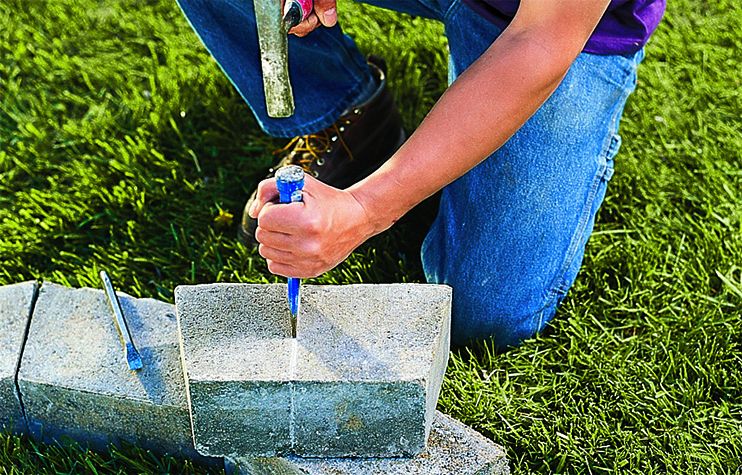
Safety should be a top priority when building and using a fire pit. You must follow local regulations and implement proper safety measures for worry-free use of your new outdoor fire pit.
Local Fire Codes
Before starting your project, research and comply with local fire codes by checking with your local fire department or city hall for specific regulations. Obtain any necessary permits before starting construction and check that your fire pit meets all size and location requirements.
Proper Ventilation
Good ventilation makes for a safe and enjoyable fire pit experience. Avoid building your fire pit in enclosed spaces to provide adequate airflow around the pit to prevent smoke buildup. Consider wind patterns when positioning your fire pit to minimize smoke blowing towards seating areas.
Safe Distance from Structures
Maintaining a safe distance from buildings and other flammable structures is most important. Place your fire pit at least 10–20 feet away from your home, fences, and other structures. Keep the area above the fire pit clear of overhanging branches or structures for a non-flammable zone of at least three feet around the pit using gravel or pavers.
Maintaining Your DIY Fire Pit
Maintenance is essential for the safety, functionality, and condition of your fire pit. Regular cleaning and seasonal care will preserve its structure and appearance.
Regular Cleaning
To keep your fire pit clean, remove the ashes after each use once they’ve cooled completely. Brush off any debris from the capstone and walls. Clean the fire ring periodically to prevent rust buildup, and regularly check for and remove any vegetation growing between the blocks.
Seasonal Maintenance
As the seasons progress, you want to pay attention to weather changes. In spring, inspect your pit for any damage that could have been caused by winter weather. Before fall, check that the drainage works properly to prevent water accumulation.
We suggest covering the pit in winter to protect it from harsh weather if you don’t plan to use it. Seasonally, you should check the stability of the blocks and reapply the adhesive as needed.
Troubleshooting Common Issues
Even with careful planning and construction, you may encounter challenges with your DIY fire pit. Uneven ground and loose blocks are common issues, so we’ve compiled the solutions to keep your pit in good condition.
Dealing with Uneven Ground
If your pit isn’t as level as you initially thought, use a longer level to check the entire area for low spots, adding or removing soil as needed to create a level base. You could also consider installing a French drain if water accumulation is an issue.
Fixing Loose Blocks
Over time, blocks may become loose due to settling or freeze-thaw cycles. Remove loose blocks and clean off old adhesive before applying fresh masonry adhesive and resetting the blocks. You can use shims if necessary to maintain level and proper alignment. Addressing these issues will maintain the structural integrity and safety of your fire pit.
